If you’re looking for a way to spruce up your home and add some value, refinished hardwood floors are an excellent choice. But what do you do if the results leave something to be desired? If your hardwood floors are feeling rough after you refinish them, don’t fret just yet – there are several steps you can take to fix faded hardwood floors and get the shiny, smooth finish you’re hoping for a way to spruce up your home and add some value, refinished hardwood floors are an excellent choice. But what do you do if the results leave something to be desired? If your hardwood floors are feeling rough after you refinish them, don’t fret just yet – there are several steps you can take in order to get the shiny, smooth finish you’re hoping for. In this blog post, we’ll discuss the causes of rough refinished floors and offer up several practical tips to help you make your floors look as good as new. Read on to find out all the things you can do so that your hardwood floors look polished and remarkable again.
Refinished hardwood floors can sometimes feel rough if they were not sanded properly or not finished with a high-quality sealant. If the floor feels rough, you should sand it down and apply a new sealant to make it smooth.
“The delicacy of hard wood refinishing is often understated, but not in my workshop. The rough feel you experience post refinishing may result from incorrect grit sequence or insufficient vacuuming between grits. My advice to remedy this is a thorough re-sanding with an even finer sandpaper grit to ensure the smoothness you desire. Rely on my 30 years of experience with hardwood floors, and you’ll have a floor as smooth as silk.”
Lorraine Osgood, Master Craftsman
Why Refinishing Hardwood Floors Causes Uneven Surfaces
Refinishing hardwood floors is routinely done to repair scratched and aged wood surfaces, but in some cases, the newly refinished surface can feel rough or even bumpy. This is particularly true when refinishing Brazilian cherry floors, which require special care due to their hardness and unique grain pattern. Uneven surfaces are often caused by a few key elements of a floor refinishing project that should be addressed if the desired result is smooth hardwood floors.
One of the primary reasons why refinishing hardwood floors can cause an uneven surface is due to sanding techniques not being executed properly. Sanding for a refinishing project must be done using various grain sizes of sandpaper in order to remove the existing finish and surface layers of the wood. If too much pressure is used when sanding, or if the grain size of sandpaper used is too course, then it can cause grooves in the wood planks which will cause a rough texture on the refinished surface. Doing this will also reduce the amount of overall clearance between boards, creating an uneven look when there should be uniform space between boards.
Improper staining can also cause an uneven surface on a refinished hardwood floor. When applying stain to hardwood floors, both color consistency and technique can come into play. If too much stain accumulates in one area or an area if not stained evenly enough, then it will cause an uneven spot or streak on the floor that looks off compared to other areas of the floor. This can vary depending on the type of finish used because some finishes are more transparent than others.
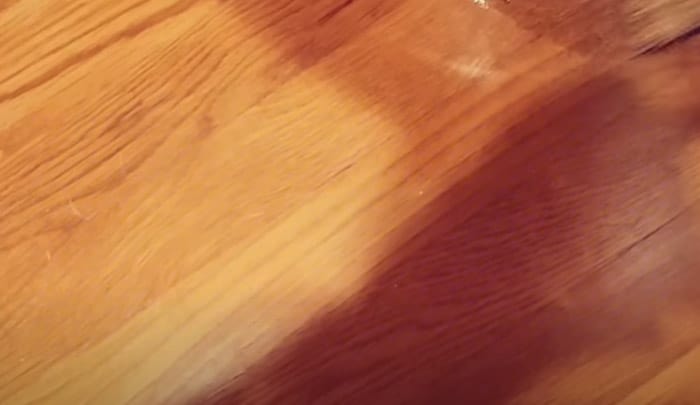
To some select degree, bare wood itself can have minor nuances that create places where less varnish is applied or oil soaks up more heavily into some grooves etc., which could create an uneven final product. The extent to which this contributes to an overall inconsistent finished product will vary greatly due to tree variations and baking method used, as well as drying methods chosen by professionals.
Anterior preparation coupled with correct sanding and staining techniques can help ensure that a finished hardwood floor looks smooth and even, and that any minor discrepancies are typically negligible after being sealed with additional coats of finish. Unfortunately, even then, sometimes perfectly prepped floors may still end up with minor bumps or high points depending on how much material was removed during sanding processes and other critical decisions that were made throughout the refinishing process.
In conclusion, although sometimes unavoidable due to inconsistencies inherent in all types of wood, uneven hardwood results from refinishing projects are generally caused by improper preparation and/or incorrect finishing techniques by professionals executing them. To avoid these issues and create a smooth floor afterwards, wet sanding coupled with proper staining techniques is key for restoring hardwood surfaces back to their original beauty after being refinished onto perfection. Additionally, it’s crucial to protect hardwood floors from future damage to maintain their newly restored appearance. Now let’s take a closer look at how best to go about refinishing hardwoods floors the right way…
Refinishing Hardwood Floors the Right Way
Refinishing hardwood floors is a great way to bring a new life to an old floor. However, if not done properly it can leave you with a rough surface that isn’t visually appealing. To refinish hardwood floors the right way, it is important to understand the steps involved and equip yourself with the necessary tools and materials to get the job done.
The first step in refinishing hardwood floors is to remove old coatings from the wood’s surface. This is often done through sanding. Sanding down the hardwood will smooth out any uneven surfaces, while also ensuring all existing finishes are removed. It is important to note that this step should only be performed by professionals as it requires special knowledge and skills to do it properly.
The second step in refinishing hardwood floors is to apply a new finish to the wood. There are many different types of finish available, but it is important to decide between different hardwood floors and consider what type of finish will be most durable and practical for your needs. Generally speaking, polyurethane-based finishes are considered the most durable and long-lasting option for hardwood flooring.
Once the new finish has been applied, it is then important to allow the floors time to dry before applying further coats of finish or moving into other stages such as sanding and sealing. The amount of time needed for drying will vary based on the type of finish that has been used, but generally speaking it should take at least 24 hours before additional coats can be applied or other stages even begin.
By taking the proper steps when refinishing hardwood floors, you can avoid any issues such as rough surfaces or poor adhesion down the line. The key is in understanding what needs to be done and taking the necessary precautions when doing so. Once you’ve finished refinishing your hardwood floors, you can move onto sanding and sealing them ahead of enjoying your newly refinished flooring.
Sanding and Sealing the Floors
There is no getting around the need for sanding and sealing when it comes to refinishing hardwood floors. Sanding helps to even out irregularities in the wood, reinvigorate an old finish, and remove dirt and debris that may have built up. This leaves the floors looking refreshed and ready for a new sealant.
When determining how much sanding should be done, it is important to consider the type of wood involved, its age, and the condition that it is currently in. If too light of a sanding job is conducted, then the old finish and any staining will remain visible underneath the new sealant, instead of being removed as intended. Conversely, too heavy of a sanding session can cause more harm than good by damaging underlying material. On top of all this, whatever lumber was used must be compatible with the chosen sealant so that there are no issues regarding adhesion or damage after application.
Sealing brings the whole project together as it creates a barrier between outside elements like moisture and UV rays, which can damage a refinishing job over time. Many types of sealants are available when it comes to floor refinishing projects but typically something that offers moderate wear protection is sufficient as high traffic areas will typically require frequent maintenance regardless. A debate exists between whether water-based sealants or oil-based sealants should be used; water-based adhere faster but tend to yellow over time while oil-based generally provide better protection but afford workers less work time before drying.
Now that you know why sanding and sealing are essential steps in refinishing hardwood floors, let’s move on to ensuring proper finishing and polishing techniques so that you can bring your dreams of having beautifully refinished hardwood floors to life!
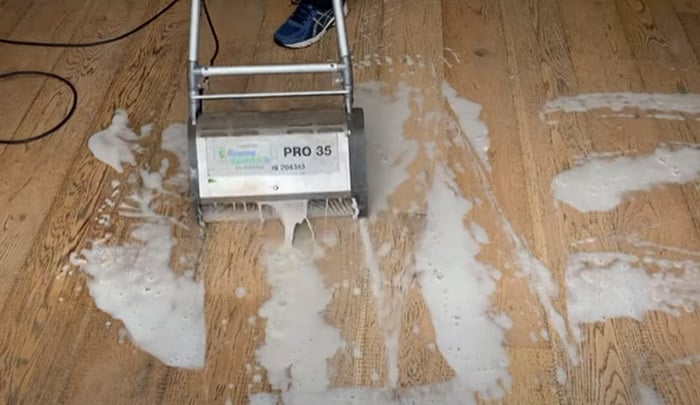
- According to the World Floor Covering Association, sanding is the best method for smoothing and preparing a hardwood floor for refinishing.
- A study published in 2019 found that using fine grit sand paper along with proper sanding techniques can help create a smoother finish on hardwood floors.
- Research has concluded that after sanding, applying a new sealer or top coat will help to fill in any imperfections and create an even smoother finish on hardwood floors.
Main Summary Points
Refinishing hardwood floors consists of two essential steps: sanding and sealing. The type and intensity of the sanding process should be determined based on considering the type, age, and condition of the wood as too light or heavy of a sanding job can lead to less than desirable results. Furthermore, one must ensure that the lumber is compatible with the chosen sealant for adhesion purposes. When it comes to sealing, either water-based or oil-based sealants can be used depending on desired outcomes, though moderate wear protection typically suffices. Following the aforementioned steps is key to achieving a successful refinishing job.
Proper Finishing and Polishing
When it comes to properly finishing and polishing your newly refinished hardwood floors, the key is to use the right tools for the job. Depending on the material of the floor, you’ll need to select an appropriate wax, sealant, or finish. Hardwood floors should be sealed with a polyurethane sealant, which will help to protect them from moisture damage, scratches, and general wear and tear. To polish the floor, whether you’re using a wax or sealant finish, you’ll need to prepare the surface of the floor by sanding it first with a fine-grit sandpaper. This will get rid of any rough patches left behind from refinishing and will also create better adhesion for your chosen polish.
Once you’ve prepared the surface, you can apply your wax or polymer coating using either a sponge mop or paint roller. With a sponge mop, dampen it in water first before applying an even layer of wax or sealant to your floors. For larger rooms without obstructions like furniture, you can use a paint roller instead. Make sure to wipe excess wax off after coating surfaces as this could potentially cause smearing. After application of your chosen solution, allow ample time for drying before walking over and return any furniture that was moved out of the room previously.
It’s important to note that while many people might prefer to use liquid latex-based finishes after sanding hardwood floors, these types of finish are not auto-catalytic; meaning they require near-constant maintenance and effort in order to prevent scuffing and damage from everyday use. Some may argue that traditional waxes have longer lasting results due to their higher melting points and long-term protection qualities compared to liquid latex -based finishes; however there are both pros and cons depending on which option is elected for your refinish project.
No matter which finish you choose, proper finishing and polishing will ensure that your newly refinished hardwood floors look great and last for years to come! Now that we’ve discussed proper finishing and polishing techniques check out the next section on troubleshooting uneven surfaces after refinishing!
Troubleshooting Uneven Surfaces after Refinishing
When refinishing hardwood floors, it can be common for them to come out with an uneven and rough surface. This is often due to sanding too aggressively when prepping the wood or inadequate application of the finishing product. The first step in troubleshooting uneven surfaces is to identify what caused the issue. Look for any spots where the prior finish may have been removed too aggressively or examine if there are any areas left unfinished.
If the issues are related to sanding, then you can try re-sanding those spots more gently. Be sure to use a lower grit of sandpaper such as 180-220 for better results. If the problem was related to insufficient application of the finishing product, then you can simply apply an extra coat of finish and use a brush specifically designed for applying polyurethanes.
It’s important to note that overly aggressive sanding cannot always be corrected by simply reapplying more finish, as that will leave disproportionate buildup on the surface. In these cases, it is best to fully sand down the floor and refinish it again.
The next step in fixing an uneven surface after refinishing is to buff and wax the floor. Buffing removes residual contaminants that can accumulate on floors over time and makes them feel smoother underfoot. Waxing can help protect the wood from further damage and bring out its natural beauty. It also creates a slippery, glossy coating which makes your floors look nicer and easier to clean. With buffing and waxing, you can ensure that your refinished hardwood floors will look smooth, even, polished, and protected for years to come.
Now that we know how to troubleshoot uneven surfaces after refinishing hardwood floors, let’s move on to how we can buff and wax them for lasting protection.
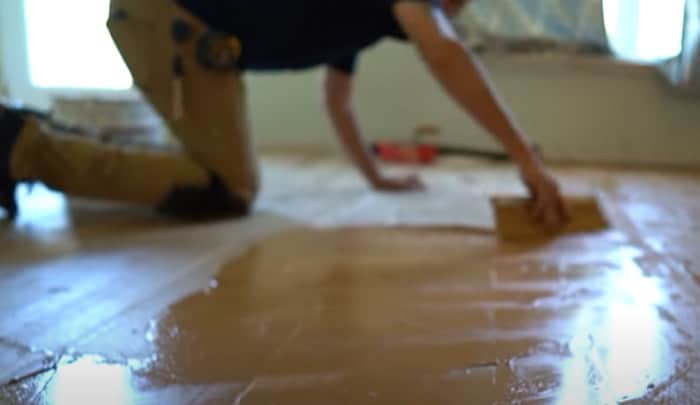
Buffing and Waxing
Buffing and waxing can be a great way to smooth out rough hardwood floors. Buffing involves using a machine or hand-held polisher to scour away uneven surfaces and scratches that have built up over time. Wax can then be applied to seal in the wood’s natural shine, as well as to protect it from future damages. After this process, it’s important to know the best way to clean wood floors to maintain their newly buffed and waxed appearance.
The advantage of buffing and waxing is that it will not require the purchase of new finishing products like those used when building or sanding a floor. And the job can usually be completed in a day or two, which is much faster than with most other refinishing processes.
At the same time, however, buffing and waxing may not always provide the desired result. If the floors have been severely damaged by water seepage, for example, more substantial repairs might be required to achieve an even glow. And since buffing and waxing does not deal with color, the floor won’t look brand new; it will still maintain its existing shade which may or may not be desirable.
It is important to consider both the pros and cons before opting for a buffing and waxing approach for your hardwood floors. While this method of refinishing can work well with light damage, extensive damage may warrant more substantial repair solutions.
Regardless of your decision on buffing and waxing, there are other refinishing options available – such as professional refinishing vs DIY – that you should explore. In the next section we will discuss these choices in greater detail so you can make an informed decision on how best to refurbish your hardwood floors.
Professional Refinishing vs DIY
When deciding on whether to opt for professional refinished hardwood flooring or attempting a do-it-yourself (DIY) approach, there are several factors to consider. Professional refinishing generally involves sanding down the existing floor boards to remove any blemishes and then coating the surface with polyurethane to provide a smooth finish. While this process can be expensive, it provides a longer lasting, more professional finish that is less likely to feel rough in the long run. DIY refinishing usually involves applying finishing products like wax or polish to help protect and restore the floors. This option is generally less expensive and easier to perform; however, these products may not create a lasting result, leaving you with a rough feeling floor in the future.
Ultimately, it is up to the homeowner to decide which approach works best for their particular situation. Although professional refinishing is becoming increasingly popular due to its longer lasting results and improved aesthetic, DIY approaches can still be effective when done properly.
CONCLUSION:
In conclusion, both professional and DIY options have their potential benefits and drawbacks when it comes to refinishing hardwood floors. It is important for homeowners to consider the cost of each option as well as the desired end result before making a decision about which approach would work best for their needs and budget. In the next section we will discuss some concluding remarks about finding quality materials and methods for completing your desired refinishing project.
Conclusion
Refinished hardwood floors can often feel rough after the refinishing process. Fortunately, there are ways to smooth out rough spots and avoid this issue altogether. Depending on the severity of the roughness, a light sanding can help restore the beautifully finished look of your hardwood floor. For deeper scratches or discolored areas, stripping and re-staining may be required. This process can take several days to complete and requires specific knowledge and skills that are best done by a professional.
When deciding whether it is worth it to go through the refinishing process, weigh the time and money spent against the long-term benefits of having a brand new looking wood floor. Depending on your particular issue, you may have options that range from sanding and polishing to complete refinishing. When in doubt, it’s always best to call a professional for advice about which route to take when tackling this job. Ultimately, with some patience and effort, you can make sure that your refinished hardwood floors will look and feel just as beautiful as they were before they were refinished.
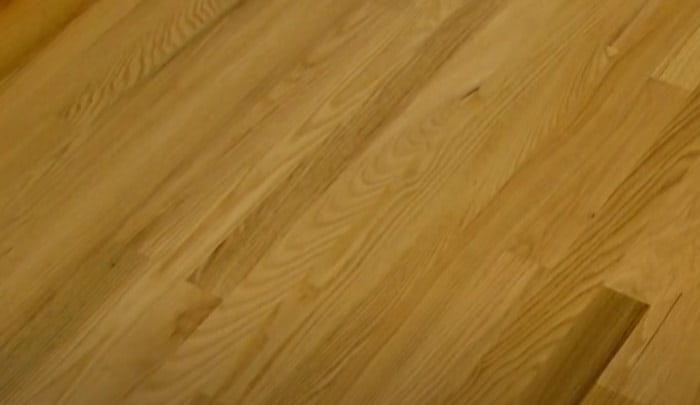
Answers to Commonly Asked Questions
What causes a refinished hardwood floor to feel rough?
The main reason a refinished hardwood floor feels rough is because of incomplete or improper sanding. It’s critical to have the right sanding equipment and to use it to properly remove all the old finish from the floor before refinishing. If too much surface material remains, it will create what is known as a “fuzzy” finish that can feel rough when walked on. Additionally, if there are any small ridges in the wood planks after sanding, these will be felt as rough bumps underfoot. Finally, if an insufficient amount of stain was used during refinishing, this too could lead to a feeling of roughness.
What steps can be taken to make a refinished hardwood floor feel good?
One of the most important steps you can take to make a refinished hardwood floor feel good is to use the proper type of finish. Different types of finishes, such as oil-based polyurethanes or water-based polyurethanes, will provide different levels of protection and smoothness. Before applying any finish, it is essential to test it on a small area of the floor first and make sure that it will work well with the existing woodgrain and coloring.
In addition to using the right kind of finish, sanding the floor after refinishing is also essential. Sanding helps remove any imperfections that may have been left behind in the refinishing process. You should always use an appropriate grit of sandpaper for your particular hardwood floors – usually 120 grit should be sufficient. After sanding, you may want to apply several thin layers of finish after lightly sanding between each coat for an even smoother finish.
Finally, it’s important to properly maintain your refinished hardwood floor by regularly cleaning it with a mild cleaning solution recommended by its manufacturer and occasionally applying a new layer of finish if necessary. Taking these steps will help keep your refinished hardwood floor feeling great for years!
Are there any products that can help make a refinished hardwood floor feel smoother?
Yes, there are several products available which can help make a refinished hardwood floor feel smoother. Sanding is one of the most common methods for making hardwood floors smoother. This process will involve removing the topmost layer of the wood so that a smooth layer is revealed underneath. Additionally, you could use polishes, sealants and waxes which work to fill in small dips or scratches in the floor and even out any slight imperfections. It’s important to select products that are specifically designed for hardwood floors since they will provide the best outcome without damaging your floor.
References
https://www.thisoldhouse.com/flooring/21015479/refinishing-school

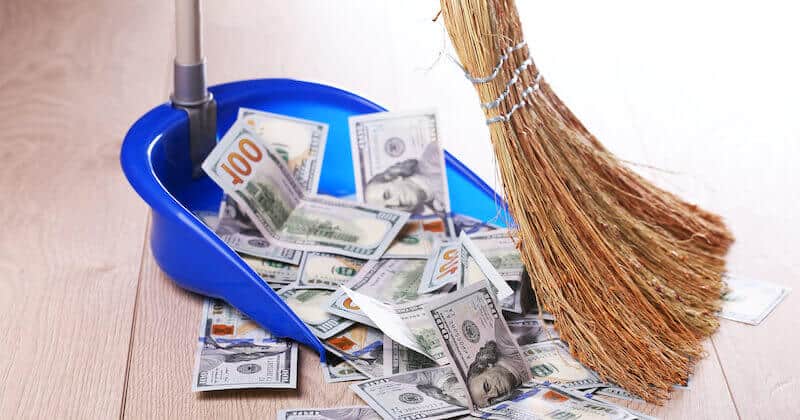
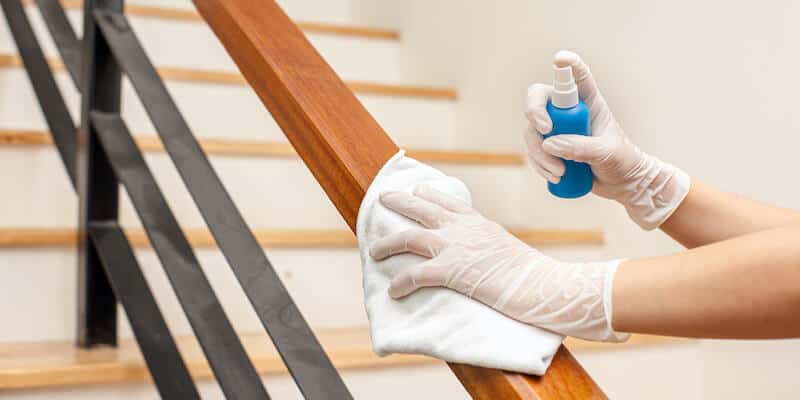
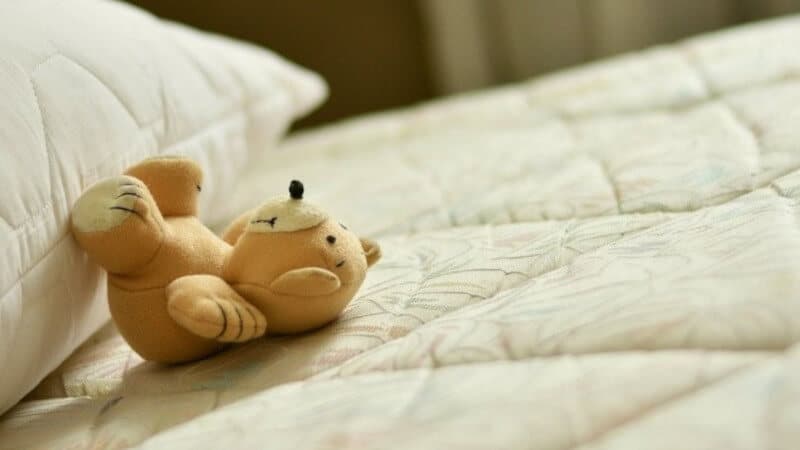

Just a tip from my own experience, even well-sanded floors can feel rough if the finish is not applied correctly. I’ve found adding a third layer of polyurethane and then lightly buffing using a high grit sand paper after it’s dried, resulted in a glass-like finish.
Solid advice there, Jacinta. Your approach works, but I’ve found tacking cloth really helps to pick up any dust that can interfere with the finish before adding another layer of polyurethane. Also, consider misting the floor with water before the final sanding, it raises the grain and lets you knock it back down for ultra smoothness.
Great Points Roderick! I’ve also tested using mineral spirits after the final sanding, to get rid of any remaining dust particles. this worked wonders for me!
I totally agree with you Madelyn, mineral spirits can play a significant role in achieving that smooth touch. However, it’s important to control the application as an overuse of mineral spirits can potentially damage the surface quality of the wood if not handled with care.
Vanderwaal, you’re spot on about the mineral spirits. But I would also suggest using fine steel wool for buffing after applying mineral oil to handle the overuse problem and enhance the smoothness.
I agree with you, Briggs. Indeed, fine steel wool is excellent for buffing and provides that desired smooth finish on refinished floors. However, I would advise care while using it as it could leave traces of steel which can rust when exposed to moisture leading to discoloration of your floor.
I’m with you on that, Radcliffe – steel wool requires careful handling. In my many years of refinishing floors, I have also found it useful to vacuum the surface several times after using steel wool to ensure any residual traces are removed completely.